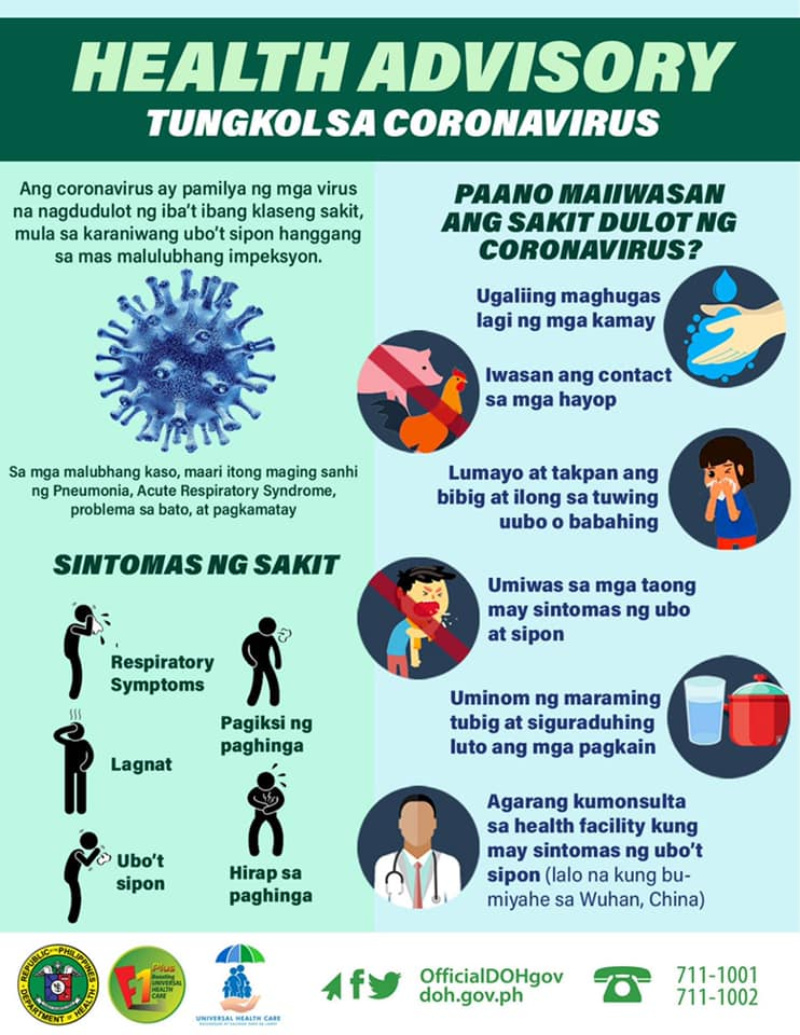
It’s not yet certain whether a Filipino child confirmed to be afflicted with coronavirus has the same strain as that found in patients in China.
A five-year-old Chinese boy was previously admitted in a Cebu City hospital after manifesting signs of fever, throat irritation and cough which he had been experiencing prior to arriving in the Philippines.
The boy’s mother did not show any symptoms. Both of them came from Wuhan City in China, the ground zero of the new coronavirus strain or the 2019-nCoV outbreak.
The boy later tested positive for the virus. The particular strain, however, is not yet known.
The World Health Organization‘s arm in the Philippnes stressed this on social media:
“To date, there is no confirmed novel #coronavirus case in the Philippines.”
“The Department of Health announced today an investigation on a 5-year-old boy with history of travel to Wuhan, China and manifested flu-like symptoms. They are also monitoring 3 cases, with no history of travel to Wuhan.”
To date, there is no confirmed novel #coronavirus case in the Philippines.@DOHgov announced today an investigation on a 5-year-old boy with history of travel to Wuhan, China and manifested flu-like symptoms. They are also monitoring 3 cases, with no history of travel to Wuhan. pic.twitter.com/unkT09tEMb
— World Health Organization Philippines (@WHOPhilippines) January 21, 2020
Health Secretary Francisco Duque III said that samples taken from the boy were tested at the Research Institute for Tropical Medicine and yielded positive for “non-specific pancoronavirus assay,” which means the strain is not yet known.
He was also negative for Severe Middle East Respiratory Syndrome-Coronavirus (MERS-CoV) and Severe Acute Respiratory Syndrome (SARS), both illnesses of which are varieties of coronaviruses.
The DOH said it is still waiting the results of the samples they sent to the Victorian Infectious Disease Reference Laboratory in Melbourne, Australia. This will help them determine if what the boy had was 2019-nCoV or not.
Three other Chinese nationals who arrived at the Kalibo International Airport and suspected to have such illness also turned out negative for the new strain. The trio have since been discharged.
The Chinese boy, meanwhile, is also recovering.
“The patient, as of (Jan. 21), is still experiencing cough but is currently stable and afebrile,” Duque said.
There’s still a lot of “blindspots” with the 2019-nCoV, Duque said, in an attempt to alleviate fears of it being as threatening as the SARS and MERS epidemics before.
The term “coronavirus” trended on Twitterverse yesterday after international media reported of the first case of a patient with the disease was found in the United States.
The patient tested positive for the 2019-nCoV after being hospitalized for pneumonia. He recently traveled to Wuhan.
The DOH posted an infographic on Facebook about the common illness and tips on how to prevent from getting sick with the infection.

One Twitter user also shared additional guidelines to perform daily.
Coronavirus has reached Philippines. First in Cebu and allegedly in Manila. Human to human transmission is also confirmed.
No vaccine available for this virus.
Reduce the risk of infection by:
– washing hands often.
– avoid touching eyes, nose, or mouth with unwashed hands.— Gabrielle 😼 (@Gabgrielle) January 21, 2020
What is coronavirus and should people worry?
Coronaviruses are actually common and most people get infected with a strain or variety at some point in their lives.
A definition from the WHO website stated that the coronavirus or CoV is “a large family of viruses that cause illness ranging from the common cold to more severe diseases such as MERS-CoV and SARS-CoV.
“Coronaviruses are zoonotic, meaning they are transmitted between animals and people,” the article added.
According to the Centers for Disease Control and Prevention, common symptoms of CoV are a runny nose, headache, cough, sore throat, fever and “a general feeling of being unwell.”
“Human coronaviruses can sometimes cause lower-respiratory tract illnesses, such as pneumonia or bronchitis. This is more common in people with cardiopulmonary disease, people with weakened immune systems, infants, and older adults,” CDC said.
China acknowledged the outbreak in Wuhan last December 31.
As of January 21, more than 200 cases have been confirmed. These included patients from the US, Thailand, Japan and South Korea. A total of six people have died.
The patients in the Philippines and Australia are currently being monitored.








